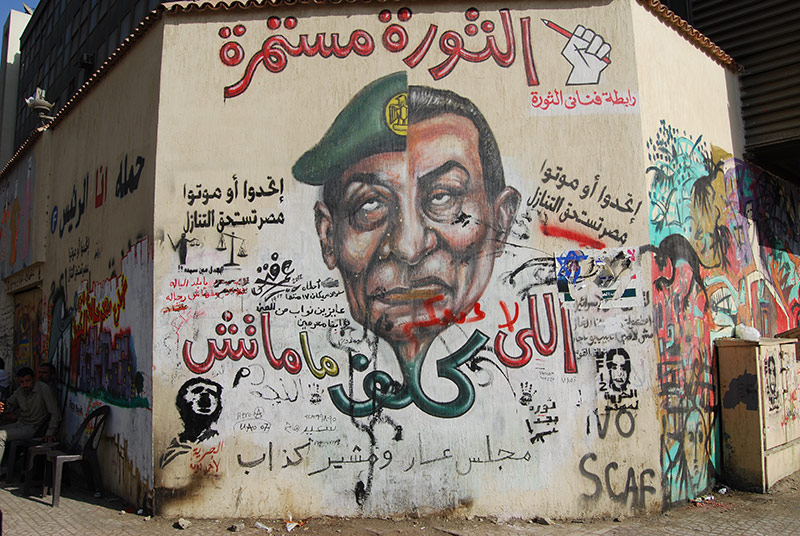‘Flock of crows: on holiday in Tahrir Square’ – by Tom Chesshyre
On my first day in Cairo during my journey across North Africa a year after the uprisings for my travel book A Tourist in the Arab Spring, I stumbled upon the Salafists of Tahrir Square. Before embarking on my journey I had little idea what a ‘Salafist’ was, but I had come to learn that the term referred to hard-line, ultra-conservative Islamists who favour a strict, puritanical version of sharia law that shuns modernity and harks back to the days of the Prophet Muhammad (at least as they choose to interpret the days of the Prophet).
The most controversial Salafists talked of jihad, a religious war to advance Islam. Their beliefs about women deeply concerned liberal-minded Egyptians; for example, the requirement to wear face veils, and a proposed ban on bikinis (outside of hotels quarantined from Egyptians, where bikinis would be allowed to maintain the tourist industry) and high heels (outside of private homes). ‘A woman can only wear high heels for her husband but she is not to do so outside her house,’ one preacher had declared. Another had said that the mingling of opposite sexes in public places should be prohibited. The Salafists of Egypt were much influenced by the Wahhabis of Saudi Arabia, who held similar beliefs and had spread their ideas into Egypt, partly through converting Egyptians who went to work in the Gulf in the 1970s to escape poverty at home.
Anyway, so there I was, on my first day, mixing with the Salafists of Tahrir Square. They wore white gowns similar to the traditional gallabiya favoured by most Egyptian men, but shortened so you could see their socks and sandals. This was the preferred Salafist style. They had gathered to demonstrate against the official disqualification of a Salafist presidential candidate named Hazem Salah Abu Ismail on the grounds that his mother was American. This was a claim he denied, saying that she only had a Green Card to live in the United States and had not converted nationality.
Images of the moon-faced politician with his bushy grey beard were on posters and placards all over the square. A popcorn stallholder, siding with his customers (one sensed his allegiance would switch depending on the day’s debate in Tahrir Square), boasted a picture of the Salafist on his wooden cart.
Ismail was in favour of women wearing veils and being segregated from men in the workplace. He would also have liked the age of marriage to be reduced to puberty, as it was during the time of the Prophet Muhammad. Some of his supporters favoured the stoning to death of adulterers and for thieves to have their hands cut off.
It is not often that one gets to mingle with such folk on a ‘holiday’. I bought a packet of sunflower seeds and salted peanuts, and strolled about. The atmosphere was a mixture of political intrigue and village fete. Munching on my sunflower seeds I listened to voices rising angrily from a small stage. Then I noticed something.
To the right of the ramshackle stage I was shocked to come across a section of swaying black fabric under a white canopy. For a split second I was reminded of a flock of crows. There was something disconcerting about the strange black space. Then I realised what I was seeing. The area under the canopy was where the Salafist women had gathered. They almost all wore full-length black robes with black veils and slits for their eyes – known as niqabs. A few did not wear veils and merely had black headscarves. The latter seemed more elderly than the others, though it was difficult to determine ages given how well covered everyone was. The women were penned into the small area behind a barrier and this was clearly the spot given over to female Salafists.
I bought a glass of orange juice from another stallholder. An eerie effigy of a man hung from a lamp post close by. I asked the stallholder who he represented. ‘This man is doing everything against them… so they hang him,’ he replied. Unlike the Salafists, the orange juice salesman wore jeans and a checked shirt. He seemed possibly more liberal than the ultra-conservatives at the demonstration – there must have been 500 people gathered in all. I inquired as to what he thought of the women in their pen.
His answer surprised me. ‘Only for her husband,’ he said, approving of the arrangement. ‘Beautiful woman, fine body…’ He indicated the shape of women’s breasts. ‘…only for her husband.’
It was a far cry from the images of Tahrir Square I had remembered from the news reports at the time of the revolution in January and February 2011, when President Mubarak stepped down after 18 days of demonstrations. Tahrir Square then had been the epicentre of the revolt, a symbol of the protest to introduce democracy, liberal ideals and a fairer system of governance in Egypt. By the time I arrived in February 2012, the political sands seemed to have shifted and another force was rising.
Eventually, of course, the less extreme Muslim Brotherhood went on to win the first properly democratic election in Egypt, only for President Morsi to be ousted by the military on the grounds of constitutional power grabbing. This left the country, considered by many to be the centre of the Arab world, in a mess. And it remains so today. The Salafists, many of whom agreed to back President Morsi in the elections to ensure an Islamist-led leadership, and other fundamentalists have taken to the streets and there has been much bloodshed.
A year after the revolutions, travelling as a tourist for my book, I knew there was trouble ahead. I also knew its source. The Salafists and the extremists were going to cause a stink. While the overthrowing of a dictator who had ruled the country for almost 30 years had captured the imagination of the world – with democracy heading for the heart of Arabia, Facebook uprisings and moderates leading the way – the reality was far removed.
And the darker side of Islam, in my view at least, was clear to see. It was the extreme Islamist position towards women. The calls for the public segregation of the sexes. The demands for the covering up of women’s bodies. The proposed bikini ban. The suggestion that the age of marriage be lowered to the age of puberty.
Was this what the Arab Spring revolution in Egypt, and perhaps in Tunisia and Libya too, would eventually lead to? Half the population wrapped up in niqabs… flocks of crows by the side of the stage.
* A Tourist in the Arab Spring by Tom Chesshyre (Bradt, £9.99)



